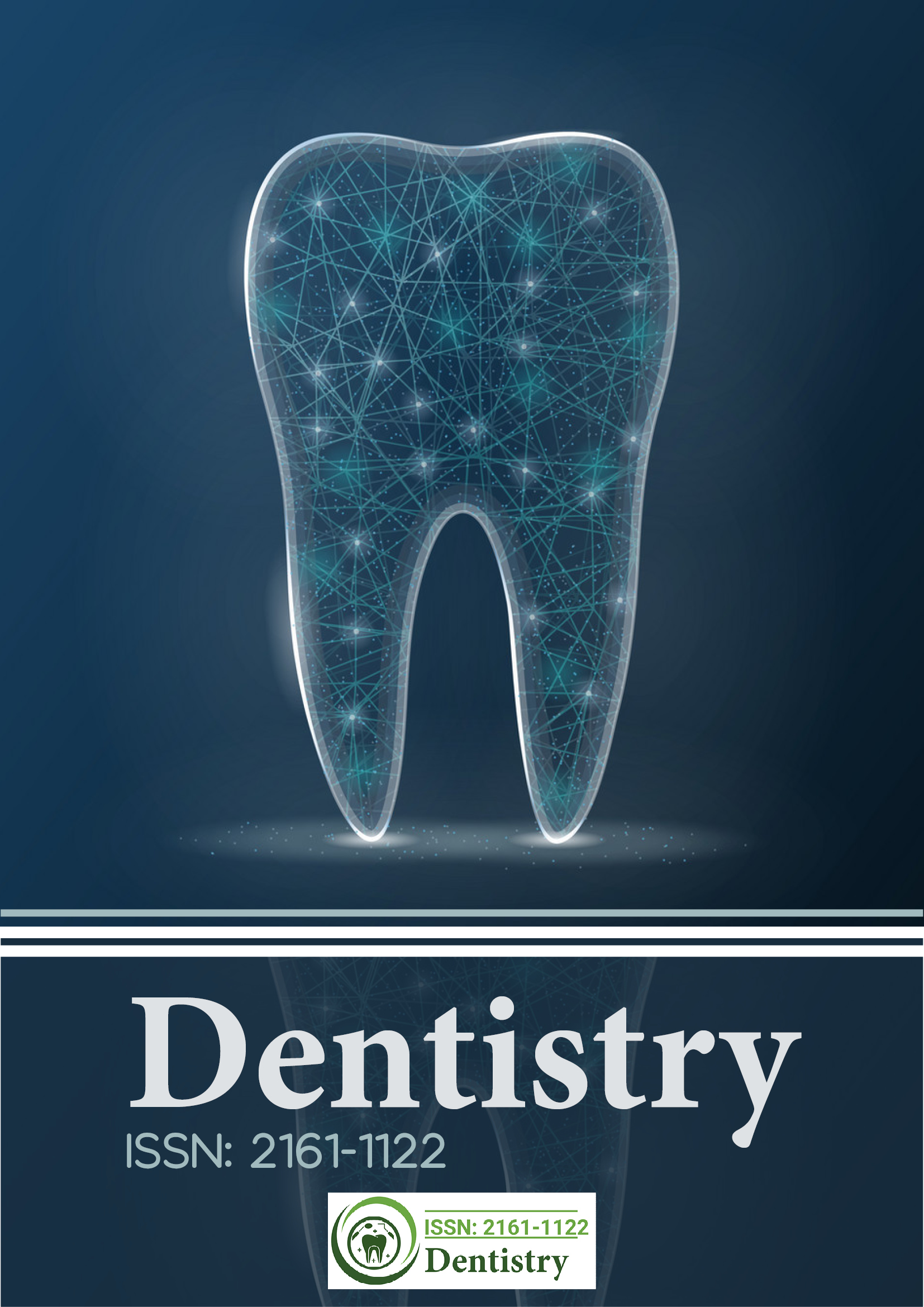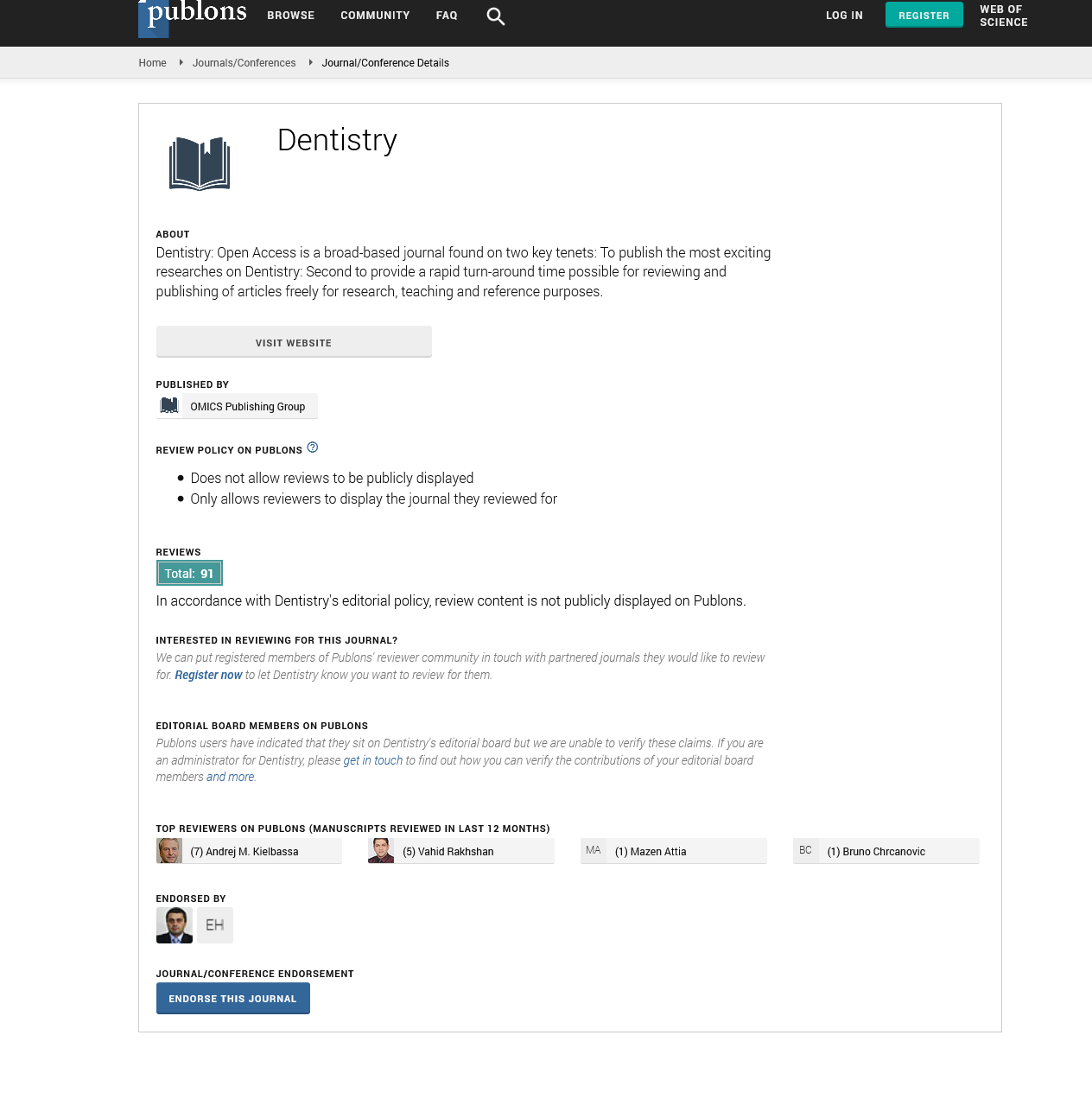Citations : 2345
Dentistry received 2345 citations as per Google Scholar report
Indexed In
- Genamics JournalSeek
- JournalTOCs
- CiteFactor
- Ulrich's Periodicals Directory
- RefSeek
- Hamdard University
- EBSCO A-Z
- Directory of Abstract Indexing for Journals
- OCLC- WorldCat
- Publons
- Geneva Foundation for Medical Education and Research
- Euro Pub
- Google Scholar
Useful Links
Share This Page
Journal Flyer

Open Access Journals
- Agri and Aquaculture
- Biochemistry
- Bioinformatics & Systems Biology
- Business & Management
- Chemistry
- Clinical Sciences
- Engineering
- Food & Nutrition
- General Science
- Genetics & Molecular Biology
- Immunology & Microbiology
- Medical Sciences
- Neuroscience & Psychology
- Nursing & Health Care
- Pharmaceutical Sciences
Opinion Article - (2024) Volume 14, Issue 2
Role and Benefits of Sedation Dentistry in Transforming Dental Care
Joyce Collins*Received: 03-Jun-2024, Manuscript No. DCR-24-26161; Editor assigned: 05-Jun-2024, Pre QC No. DCR-24-26161 (PQ); Reviewed: 19-Jun-2024, QC No. DCR-24-26161; Revised: 26-Jun-2024, Manuscript No. DCR-24-26161 (R); Published: 03-Jul-2024, DOI: 10.35248/2161-1122.23.14.691
Description
Sedation dentistry, also known as sleep dentistry, is a significant advancement in dental care and is primarily used for patients who are trying about visiting the dentist. It involves the administration of sedative medications to help patients relax during dental procedures. Sedation can range from minimal, where patients are awake but relaxed, to deep sedation, where patients are on the edge of consciousness but can still be stimulated. This field of dentistry has developed to improve the patient experience and ensure that individuals receive the necessary oral care. Dental anxiety is a common issue, affecting a large portion of the population, this anxiety is so severe that it prevents them from seeking dental care altogether, leading to the wear of oral health. Poor oral health can contribute to various systemic health problems, including cardiovascular disease, diabetes, and respiratory infections. Sedation dentistry addresses this issue by providing a means for patients to receive necessary treatments in a comfortable and concern free environment. Nitrous Oxide Sedation, often referred to as laughing gas, nitrous oxide is a mild sedative inhaled through a mask placed over the nose. Oral sedation can produce mild to moderate sedation, depending on the dosage.
The main advantage of sedation dentistry is that it helps patients feel less disturbed so they can undergo necessary dental procedures without feeling low or uncomfortable. Improved oral health by improving anxiety, sedation dentistry encourages regular dental visits and timely treatments, which are essential for maintaining good oral health. Sedation helps manage pain and discomfort during procedures, making the dental experience more pleasant. It also allows for multiple treatments to be performed in a single visit, saving time and reducing the number of appointments needed. Relaxed patients are easier to treat, leading to more efficient and effective procedures. Dentists can work more precisely and for longer periods without causing distress to the patient. Sedation dentistry makes dental care open to individuals with special needs, including those with physical disabilities, behavioral issues, or severe crack responses.
While sedation dentistry suggest numerous benefits, it is essential to consider the potential risks and ensure that it is administered safely. Prior to undergoing sedation, patients should go through medical evaluation to identify any underlying health conditions that could affect the use of sedatives. It is also important to provide a complete medical history, including any medications currently being taken, as these can interact with sedative agents. During the procedure, patients should be continuously monitored to ensure their safety. This includes tracking vital signs such as heart rate, blood pressure, and oxygen levels. The dental team should be trained in emergency procedures and equipped to handle any adverse reactions that may occur. They should follow any post-procedure instructions provided by the dentist to ensure a smooth recovery.
The field of sedation dentistry is frequently evolving with ongoing research aimed at improving the safety and effectiveness of sedative agents and techniques. Advances in pharmacology are leading to the development of new sedative medications with fewer side effects and faster recovery times. Additionally, technological innovations, such as advanced monitoring equipment and digital sedation systems, are enhancing the precision and safety of sedation practices. The integration of sedation dentistry into general dental practices is also increasing, making it more accessible to a larger range of patients. As public awareness of sedation options grows, more individuals are likely to seek out dental care, overcoming their fears.
Patient references highlight the transformative impact of sedation dentistry on their oral health care journeys. Many individuals who previously avoided dental visits due to fear now report a sense of relief and satisfaction with their treatments. They appreciate the kind approach of dental professionals who understand and address their concerns. For example, one patient described their experience with oral sedation as lifechanging, allowing them to undergo multiple restorative procedures in a single visit without distress. Another patient, who opted for IV sedation for a complex dental surgery, expressed gratitude for the pain-free and anxiety-free experience, noting that it made them more likely to return for regular check-ups and preventive care. These positive experiences underscore the importance of sedation dentistry in helping overall health and well-being. By removing barriers to dental care, sedation dentistry helps individuals maintain healthy teeth and gums.
Citation: Collins J (2024) Role and Benefits of Sedation Dentistry in Transforming Dental Care. J Dentistry. 14:691.
Copyright: © 2024 Collins J. This is an open access article distributed under the terms of the Creative Commons Attribution License, which permits unrestricted use, distribution, and reproduction in any medium, provided the original author and source are credited.

